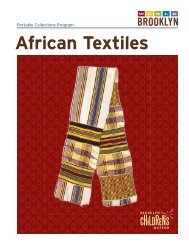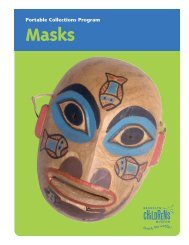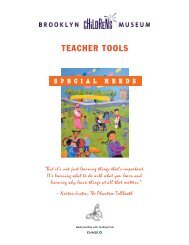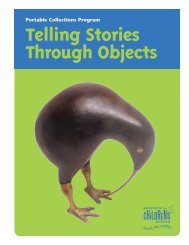Chinese New Year - Brooklyn Children's Museum
Chinese New Year - Brooklyn Children's Museum
Chinese New Year - Brooklyn Children's Museum
You also want an ePaper? Increase the reach of your titles
YUMPU automatically turns print PDFs into web optimized ePapers that Google loves.
information for the teacher<br />
<strong>Chinese</strong> <strong>New</strong> <strong>Year</strong><br />
Of all the traditional <strong>Chinese</strong> festivals, <strong>Chinese</strong><br />
<strong>New</strong> <strong>Year</strong> is the most colorful, elaborate,<br />
and joyous. <strong>Chinese</strong> <strong>New</strong> <strong>Year</strong> is celebrated in<br />
<strong>Chinese</strong> communities all over the world,<br />
including <strong>Brooklyn</strong>, Manhattan, and Queens.<br />
The first day of the <strong>New</strong> <strong>Year</strong> celebration<br />
usually falls between late January and<br />
February. <strong>Chinese</strong> <strong>New</strong> <strong>Year</strong> is celebrated on<br />
the first day of the first moon of the lunar<br />
calendar. The <strong>Chinese</strong> calendar measures a<br />
year according to the moon and its cycles.<br />
The <strong>Chinese</strong> <strong>New</strong> <strong>Year</strong> or Lunar <strong>New</strong> <strong>Year</strong>, as<br />
it is also known, is celebrated in many Asian<br />
countries. The celebration may last from one day<br />
to two weeks depending on who is celebrating.<br />
<strong>New</strong> <strong>Year</strong> Preparations<br />
As with all festivals and holidays, each family<br />
may have their own traditions for celebrating<br />
<strong>Chinese</strong> <strong>New</strong> <strong>Year</strong>. In general, however,<br />
preparations for the <strong>Chinese</strong> <strong>New</strong> <strong>Year</strong> often<br />
begin as much as a month ahead of time.<br />
People prepare for the <strong>New</strong> <strong>Year</strong> by getting rid<br />
of bad luck from the past year and ensuring<br />
a good start to the new one. Having a clean<br />
house, all bills paid, and everything in order as<br />
the <strong>New</strong> <strong>Year</strong> arrives is very important, as is<br />
visiting with friends and family.<br />
Just as some people decorate for Halloween<br />
and the winter holiday season, many people<br />
who celebrate <strong>Chinese</strong> <strong>New</strong> <strong>Year</strong> decorate<br />
their homes and businesses for the special<br />
holiday. Red and gold are the colors of the<br />
<strong>New</strong> <strong>Year</strong> season; red signifies joy and luck<br />
and gold represents wealth. Lanterns are<br />
made, or bought, and hung around the house<br />
and on the streets. Banners decorated with<br />
symbols of good fortune are also popular.<br />
The Fu [FOO, in Mandarin] character of good<br />
luck is hung upside down because the <strong>Chinese</strong><br />
word for “arrive” sounds similar to the word<br />
for “upside down.” It means good luck is<br />
coming. Homes are decorated with red-paper<br />
spring couplets expressing good fortune<br />
and good wishes for the <strong>New</strong> <strong>Year</strong>. Blooming<br />
flowers are a sign of good luck and long<br />
life. Fruit such as oranges, tangerines, and<br />
kumquats are symbolic of wealth and given in<br />
pairs or even numbers during the <strong>New</strong> <strong>Year</strong><br />
to bring wishes for sweetness and wealth and<br />
used as decorations. Like the Fu symbol’s play<br />
on words, tangerine and gold are pronounced<br />
the same way in Cantonese.<br />
Having plenty of food for the celebration<br />
promises a year with enough food for the<br />
family. Many families prepare special dishes<br />
for a feast on the eve of <strong>Chinese</strong> <strong>New</strong> <strong>Year</strong>.<br />
Often the ingredients have names similar<br />
to words like “good fortune” “longevity,”<br />
“health,” and “prosperity.” Fried dumplings,<br />
which look like ingots of gold, and noodles,<br />
which stand for long life (if you can slurp a<br />
noodle whole, you will have a long life). Fish,<br />
which is almost always eaten on <strong>Chinese</strong><br />
<strong>New</strong> <strong>Year</strong>’s Eve, represents togetherness and<br />
abundance in the coming year. Families enjoy<br />
snacking on all the sweet pastries, nuts, and<br />
candies that served just for this time. A Tray<br />
of Togetherness, for example, is a special<br />
round dish with eight compartments containing<br />
dried fruits, seeds, sweets, and candies.<br />
Each treat has a special meaning and is eaten<br />
to ensure a sweet year. The circular tray<br />
symbolizes togetherness.<br />
<strong>Chinese</strong> <strong>New</strong> <strong>Year</strong> | 8








